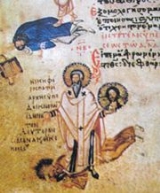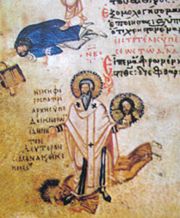
Patriarch Nikephoros I of Constantinople
Encyclopedia

Greek language
Greek is an independent branch of the Indo-European family of languages. Native to the southern Balkans, it has the longest documented history of any Indo-European language, spanning 34 centuries of written records. Its writing system has been the Greek alphabet for the majority of its history;...
: Νικηφόρος Α΄, Nikēphoros I ), (c. 758 – April 5, 828) was a Christian
Christianity
Christianity is a monotheistic religion based on the life and teachings of Jesus as presented in canonical gospels and other New Testament writings...
Byzantine
Byzantine Empire
The Byzantine Empire was the Eastern Roman Empire during the periods of Late Antiquity and the Middle Ages, centred on the capital of Constantinople. Known simply as the Roman Empire or Romania to its inhabitants and neighbours, the Empire was the direct continuation of the Ancient Roman State...
writer and Ecumenical Patriarch of Constantinople from April 12, 806, to March 13, 815.
He was born in Constantinople
Constantinople
Constantinople was the capital of the Roman, Eastern Roman, Byzantine, Latin, and Ottoman Empires. Throughout most of the Middle Ages, Constantinople was Europe's largest and wealthiest city.-Names:...
as the son of Theodore and Eudokia, of a strictly orthodox family, which had suffered from the earlier Iconoclasm. His father Theodore, one of the secretaries of Emperor Constantine V
Constantine V
Constantine V was Byzantine emperor from 741 to 775; ); .-Early life:...
Kopronymos, had been scourged and banished to Nicaea for his zealous support of Iconodules, and the son inherited the religious convictions of the father. Nevertheless, he entered the service of the Empire, became cabinet secretary, and under Irene
Irene (empress)
Irene Sarantapechaina , known as Irene of Athens or Irene the Athenian was a Byzantine empress regnant from 797 to 802, having previously been empress consort from 775 to 780, and empress dowager and regent from 780 to 797. It is often claimed she called herself "basileus" , 'emperor'...
took part in the synod of 787 as imperial commissioner. He then withdrew to one of the cloister
Cloister
A cloister is a rectangular open space surrounded by covered walks or open galleries, with open arcades on the inner side, running along the walls of buildings and forming a quadrangle or garth...
s that he had founded on the eastern shore of Bosporos, until he was appointed director of the largest home for the destitute in Constantinople c. 802.
After the death of the Patriarch Tarasios, although still a layman
Laity
In religious organizations, the laity comprises all people who are not in the clergy. A person who is a member of a religious order who is not ordained legitimate clergy is considered as a member of the laity, even though they are members of a religious order .In the past in Christian cultures, the...
, he was chosen patriarch by the wish of the emperor (Easter
Easter
Easter is the central feast in the Christian liturgical year. According to the Canonical gospels, Jesus rose from the dead on the third day after his crucifixion. His resurrection is celebrated on Easter Day or Easter Sunday...
, April 12, 806). The uncanonical choice met with opposition from the strictly clerical party of the Stoudites
Stoudios
The Monastery of Stoudios, more fully Monastery of Saint John the Forerunner "at Stoudios" The Monastery of Stoudios, more fully Monastery of Saint John the Forerunner "at Stoudios" The Monastery of Stoudios, more fully Monastery of Saint John the Forerunner "at Stoudios" (Greek Μονή του Αγίου...
, and this opposition intensified into an open break when Nikephoros, in other respects a very rigid moralist, showed himself compliant to the will of the emperor by reinstating the excommunicated priest Joseph.
After vain theological disputes, in December 814, there followed personal insults. Nikephoros at first replied to his removal from his office by excommunication, but was at last obliged to yield to force, and was taken to one of the cloisters he had founded, Tou Agathou, and later to that called Tou Hagiou Theodorou. From there he carried on a literary polemic
Polemic
A polemic is a variety of arguments or controversies made against one opinion, doctrine, or person. Other variations of argument are debate and discussion...
for the cause of the iconodules against the synod of 815
Council of Constantinople (815)
The Council of Constantinople of 815 was held in the Byzantine capital, in the Hagia Sophia, and initiated the second period of the Byzantine Iconoclasm....
. On the occasion of the change of emperors, in 820, he was put forward as a candidate for the patriarchate and at least obtained the promise of toleration.
He died at the monastery of Saint Theodore (Hagiou Theodorou), revered as a confessor
Confessor
-Confessor of the Faith:Its oldest use is to indicate a saint who has suffered persecution and torture for the faith, but not to the point of death. The term is still used in this way in the East. In Latin Christianity it has come to signify any saint, as well as those who have been declared...
. His remains were solemnly brought back to Constantinople by the Patriarch Methodios
Patriarch Methodios I of Constantinople
St. Methodios I or Methodius I , was Ecumenical Patriarch of Constantinople from March 4, 843 to June 14, 847. He was born in Syracuse and died in Constantinople...
on March 13, 847, and interred in the Church of the Holy Apostles
Church of the Holy Apostles
The Church of the Holy Apostles , also known as the Imperial Polyandreion, was a Christian church built in Constantinople, capital of the Eastern Roman Empire, in 550. It was second only to the Church of the Holy Wisdom among the great churches of the capital...
, where they were annually the object of imperial devotion. His feast is celebrated on this day both in the Greek and Roman Churches; the Greeks also observe 2 June as the day of his death.
Compared with Theodore of Stoudios
Theodore the Studite
Theodore the Studite was a Byzantine Greek monk and abbot of the Stoudios monastery in Constantinople. He played a major role in the revivals both of Byzantine monasticism and of classical literary genres in Byzantium...
, Nikephoros appears as a friend of conciliation, learned in patristics
Patristics
Patristics or Patrology is the study of Early Christian writers, known as the Church Fathers. The names derive from the Latin pater . The period is generally considered to run from the end of New Testament times or end of the Apostolic Age Patristics or Patrology is the study of Early Christian...
, more inclined to take the defensive than the offensive, and possessed of a comparatively chaste, simple style. He was mild in his ecclesiastical and monastical rules and non-partisan in his historical treatment of the period from 602 to 769 (Historia syntomos, breviarium). He used the chronicle of Traianus Patricius.
His tables of universal history (Chronographikon syntomon), in passages extended and continued, were in great favor with the Byzantines, and were also circulated outside the Empire in the Latin version of Anastasius Bibliothecarius
Anastasius Bibliothecarius
Anastasius Bibliothecarius was Head of archives and antipope of the Roman Catholic Church.- Family and education :...
, and also in Slavonic translation. The Chronography offered a universal history from the time of Adam and Eve
Adam and Eve
Adam and Eve were, according to the Genesis creation narratives, the first human couple to inhabit Earth, created by YHWH, the God of the ancient Hebrews...
to his own time. To it he appended a canon catalog (which does not include the Revelation
Revelation
In religion and theology, revelation is the revealing or disclosing, through active or passive communication with a supernatural or a divine entity...
of John). The catalog of the accepted books of the Old and New Testaments is followed by the antilegomena
Antilegomena
Antilegomena, a direct transliteration from the Greek , refers to written texts whose authenticity or value is disputed.Eusebius in his Church History written c. 325 used the term for those Christian scriptures that were "disputed" or literally those works which were "spoken against" in Early...
(including Revelation) and the apocrypha
Apocrypha
The term apocrypha is used with various meanings, including "hidden", "esoteric", "spurious", "of questionable authenticity", ancient Chinese "revealed texts and objects" and "Christian texts that are not canonical"....
. Next to each book is the count of its lines, his stichometry
Stichometry of Nicephorus
The Stichometry of Nicephorus is a stichometry by Patriarch Nicephorus I of Constantinople. It is significant in that it counts the number of lines of various Christian texts, many of which were later suppressed by the church and lost...
, to which we can compare our accepted texts and judge how much has been added or omitted. This is especially useful for apocrypha for which only fragmentary texts have survived.
The principal works of Nikephorus are three writings referring to iconoclasm
Iconoclasm
Iconoclasm is the deliberate destruction of religious icons and other symbols or monuments, usually with religious or political motives. It is a frequent component of major political or religious changes...
:
- Apologeticus minor, probably composed before 814, an explanatory work for laymen concerning the tradition and the first phase of the iconoclastic movement;
- Apologeticus major with the three Antirrhetici against MamonasMamonasMamomas can refer to municipalities in Bahia, Piauí, and Minas Gerais. For the municipality in Piauí see Manonas, Piauí; for the municipality in Bahia see Mamonas, Bahia. This article refers to Mamonas, Minas Gerais....
-Constantine Kopronymos, a complete dogmatics of the belief in images, with an exhaustive discussion and refutation of all objections made in opposing writings, as well as those drawn from the works of the FathersChurch FathersThe Church Fathers, Early Church Fathers, Christian Fathers, or Fathers of the Church were early and influential theologians, eminent Christian teachers and great bishops. Their scholarly works were used as a precedent for centuries to come...
;
- The third of these larger works is a refutation of the iconoclastic synod of 815 (ed. Serruys, Paris, 1904).
Nikephoros follows in the path of John of Damascus
John of Damascus
Saint John of Damascus was a Syrian monk and priest...
. His merit is the thoroughness with which he traced the literary and traditional proofs, and his detailed refutations are serviceable for the knowledge they afford of important texts adduced by his opponents and in part drawn from the older church literature.
External links
- Development of the Canon of the New Testament: the Stichometry of Nicephorus
- St. Nicephorus (Catholic EncyclopediaCatholic EncyclopediaThe Catholic Encyclopedia, also referred to as the Old Catholic Encyclopedia and the Original Catholic Encyclopedia, is an English-language encyclopedia published in the United States. The first volume appeared in March 1907 and the last three volumes appeared in 1912, followed by a master index...
)

